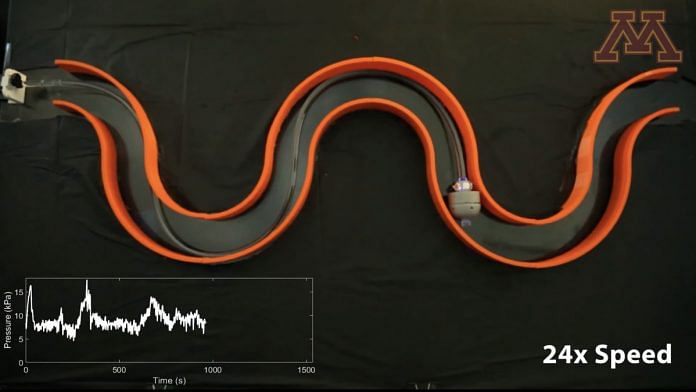Scientists from the University of Minnesota have developed a first-of-its-kind soft robot that can grow like a plant. The study was published in the journal Proceedings of the National Academy of Sciences.
The plant-inspired extrusion process that enables synthetic material growth will allow researchers to build better soft robots that can navigate hard-to-reach places, complicated terrain, and potentially areas within the human body.
Soft robotics is an emerging field where robots are made of soft, pliable materials as opposed to rigid ones.
Current soft-growing robots drag a trail of solid material behind them and use heat and/or pressure to transform that material into a more permanent structure.
Previously, this trail was more difficult to pull around bends and turns, making it hard for the robots to navigate terrain with obstacles or winding paths.
The research team solved this problem by developing a new means of extrusion, a process where material is pushed through an opening to create a specific shape. This allows the robot to create its synthetic material from a liquid instead of a solid.
The researchers were able to mimic plants by using a technique called photopolymerization, which uses light to transform liquid monomers into a solid material.
Using this technology, the soft robot can more easily navigate obstacles and winding paths without having to drag any solid material behind it. Read more
Also Read: West Antarctica glacier disintegrating faster than thought
The James Webb image captured ancient star clusters
Using the James Webb Space Telescope (JWST), researchers from the Canadian NIRISS Unbiased Cluster Survey (CANUCS) team have found what could possibly be “amongst the earliest observed objects to have quenched their star formation in the Universe”.
The study published in The Astrophysical Journal Letters, centers around the first deep field image released by the JWST. Researchers zeroed in on “the Sparkler galaxy”, located nine billion light years away.
The galaxy got its name for the compact objects appearing as small yellow-red dots surrounding it, referred to by the researchers as “sparkles”.
The team posited that these sparkles could either be young clusters actively forming stars — born three billion years after the Big Bang at the peak of star formation — or old globular clusters. Globular clusters are ancient collections of stars from a galaxy’s infancy and contain clues about its earliest phases of formation and growth.
From their initial analysis of 12 of these compact objects, the researchers determined that five of them are globular clusters and thus among “the earliest stars the universe created”. Read more
Also Read: Gene mutation made modern humans produce more neurons than Neanderthals
Aerosols can worsen climate change depending on where it’s emitted from
The impacts of aerosols on human health, economies, and agriculture, differ drastically depending on where they are emitted from, according to scientists from University of Texas at Austin and the University of California San Diego.
The research, published in the journal Science Advances, is the first to simulate how aerosol pollution affects both climate and air quality for locations around the globe.
Aerosols are tiny solid particles and liquid droplets that contribute to smog and are emitted from industrial factories, power plants and vehicle tailpipes. They impact human health, agricultural and economic productivity in unique global patterns when compared with carbon dioxide (CO2) emissions, which are the focus of efforts to mitigate climate change.
The researchers found that, depending on where they are emitted, aerosols can worsen the social costs of carbon — a measure of the economic costs of greenhouse gases on society — by as much as 66%.
To study aerosols’ influence in comparison to CO2, the team ran climate simulations for eight regions that produced identical aerosol emissions and mapped how temperature, precipitation, and surface air quality were affected in these regions and across the world.
They then connected this data with known relationships between climate and air quality and infant mortality, crop productivity, and GDP across different regions.
The team found that the emissions from some regions produce climate and air quality effects that range from two to 10 times as strong as others. Additionally, social costs can sometimes affect neighbouring regions more than the region that produced the aerosol emissions.
For example, in Europe local emissions result in four times as many infant deaths outside Europe as within. Read more
Earths core is not just carbon heavy, also has deposits of diamonds
At the Earth’s core-mantle boundary, carbon separates from the liquid iron-metal alloy and forms diamonds.
Byeongkwan Ko, a recent Ph.D. graduate from Arizona State University, and his colleagues recently published their findings on the core-mantle boundary in the journal Geophysical Research Letters.
The Earth’s core is the largest carbon storage on Earth — roughly 90 per cent is buried there.
The team at Arizona State University showed that the oceanic crust that sits on top of tectonic plates and falls into the interior contains hydrous minerals and can sometimes descend all the way to the core-mantle boundary.
The temperature at the core-mantle boundary is at least twice as hot as lava, and high enough that water can be released from the hydrous minerals.
Therefore, a chemical reaction similar to rusting steel could occur at Earth’s core-mantle boundary.
This reaction at the core-mantle boundary forms diamond.
The team will continue investigating how the reaction can also change the concentration of other light elements in the core, such as silicon, sulphur and oxygen, and how such changes can impact the mineralogy of the deep mantle. Read more
(Edited by Theres Sudeep)
Also Read: Dinosaurs may have been on a decline long before the fateful asteroid hit Earth



